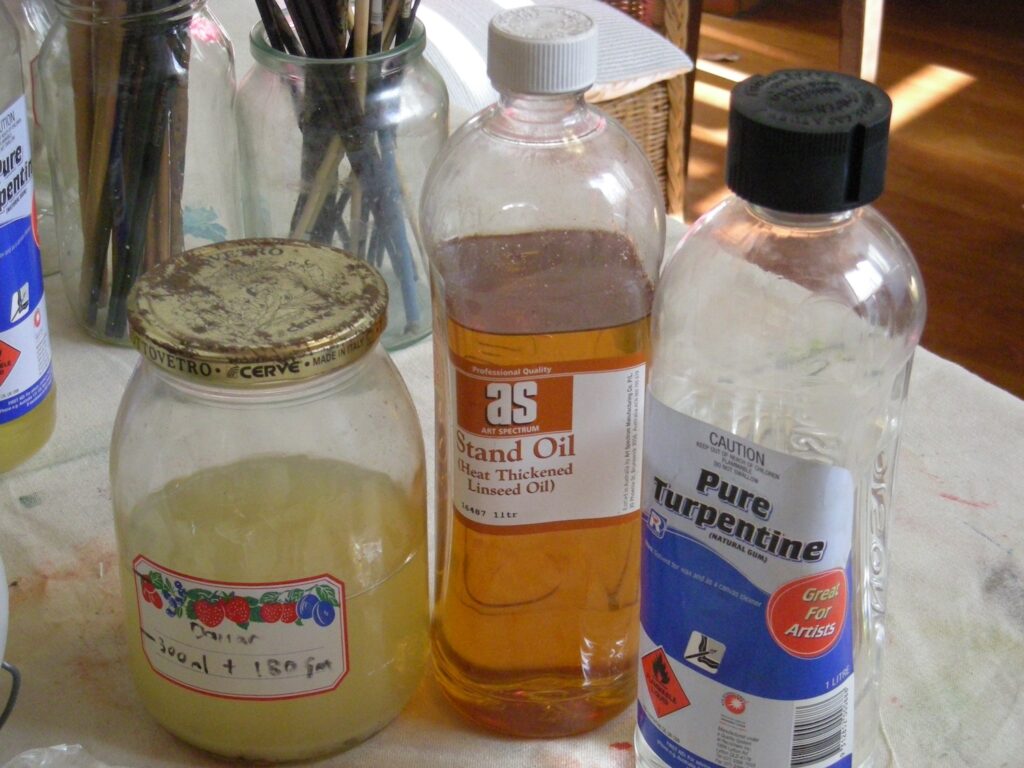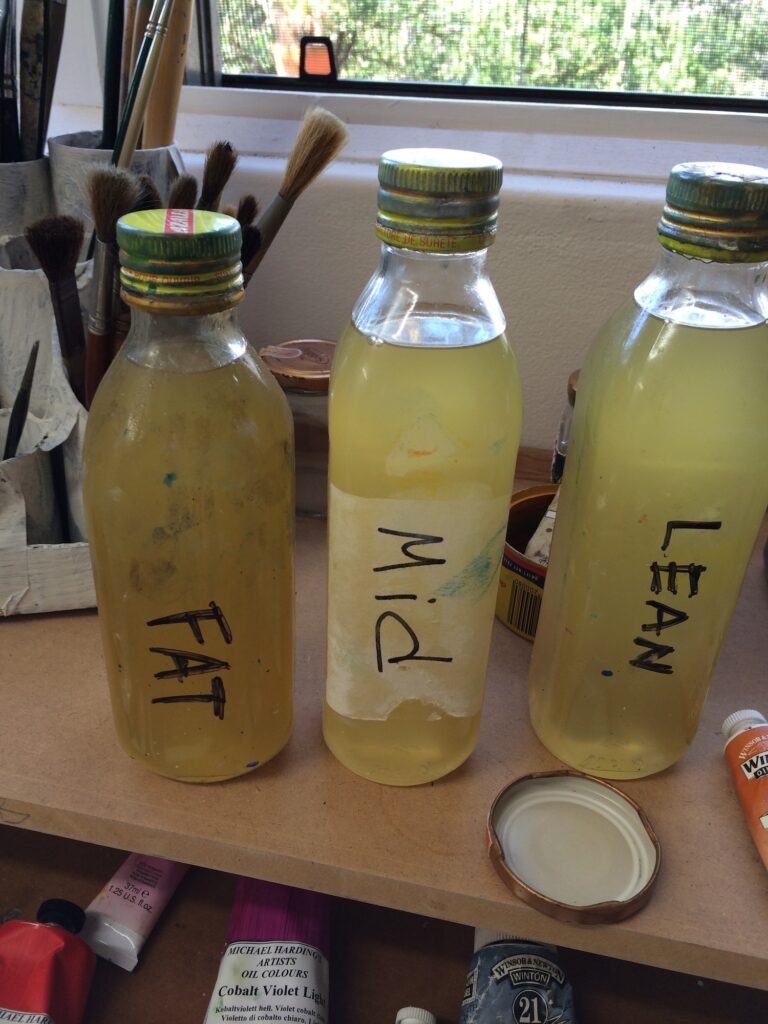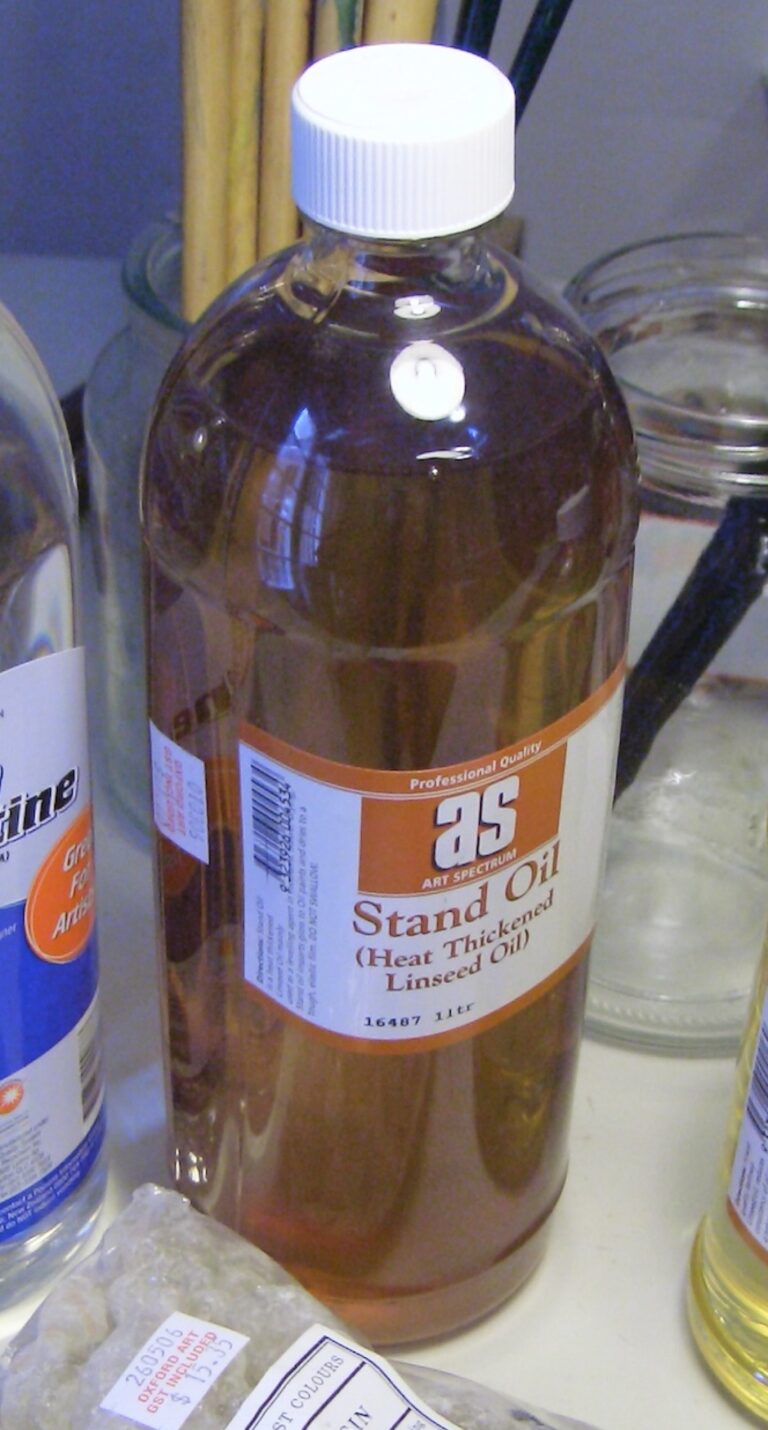Oil Painting Medium Recipe

I just mixed up another batch of the medium I use for oil painting. I seem to always loose or forget the recipe so I decided to store it here for safe keeping. This is a simple recipe with damar resin, stand oil and gum turps. I don’t bother with dryers or other ingredients… too lazy.
You can of course buy a ready-made medium but they generally don’t tell you what’s in them and also I find something meditative about preparing my own. It’s a method of procrastination that feels as if you are doing something art related – anything but actually face the risky business of painting.
More detail below but in brief, the recipe for the medium I use is in the proportions 1:2:5. That is, one part damar mixing varnish, two parts stand oil and five parts refined turpentine. This gives me the Fat mix as a starting point then I pour some off and add a little more turps for the Mid and again for the Lean underpainting mix as well. Having these three mixes is useful for working from Lean to Fat layers of the oil painting.

Oil paint straight from the tube has varying consistency so to get your paint to that nice buttery consistency that makes it workable, it may need to be thinned. Ideally you wouldn’t do this, as it’s better to avoid breaking the paint down at all but the reality is that paint comes out of each tube differently.
To thin oils, some painters just use gum turps (also known as refined turps). This is quick and easy and tends to give a flat or dull finish to the paint. The main problem with using just turps is it can thin the paint out so much that the binder is unable to hold the pigment together, resulting in the paint surface breaking down over time. In fact that’s why it has a dull finish, the gloss surface has been broken down and absorbs more light.
If you really love that thinned-out wash-of-paint technique then perhaps acrylics are a better option. Oils are, well… oily and shiny by nature, so back to the medium… basically, there are three things involved in preparing paint for application, the oil paint from the tube, a binder and a volatile solvent (Depending on quality, the paint may already have lots of ingredients in it too but let’s forget that for the moment).
As mentioned above, the recipe for the medium I use is in the proportions 1:2:5. That is, one part damar mixing varnish, two parts stand oil and five parts refined turpentine.
1 Part - Damar Mixing Varnish
Damar is resin from trees and is included to give gloss and, along with the stand oil, it becomes the binder the paint pigment is suspended in after the turps has evaporated off. You can buy damar resin already dissolved in turps as a Damar Finishing Varnish for use over finished paintings, this is a good thing for conservation purposes as it can be removed later with turps. For an oil painting medium the damar and turps are mixed in different proportions as a Damar Mixing Varnish. To avoid a brittle paint finish the total resin content in the final mix, excluding the turps, shouldn’t be much more than 15% by volume.
I buy the damar resin crystals and mix them with pure turps in a ratio that comes from what is called a ‘five pound cut’. The 5lb cut is five pounds of resin with 1 gallon of pure turpentine and produces a thick, opaque fluid, a bit like thin honey. To convert this into a usable metric equivalent, 5 pounds rounds to 2.27 kilograms and 1 gallon rounds 4.55 litres. That works out as a ratio of 0.5 resin to 1 turps or 500 grams of resin to 1 litre of turps. Smaller and more useful units to work from is 50gm of resin to 100ml turps.

When you mix the resin and pure turps, you leave it to soak for a day or two, perhaps give the jar a swirl to help the process of the resin dissolving. There may be sediment that comes out of the resin – bits of the tree it came from I guess. You can strain it through cloth or a sieve or just let it settle and pour it off however you do it, you probably don’t want that stuff ending up trapped in your oil painting.
2 Parts - Stand Oil
Stand oil is just linseed oil that has been heated to the point where its molecular structure changes. When linseed oil is heated to somewhere around 275-300 degrees Celsius for several hours it polymerises. Something to do with the polyunsaturated fats in the linseed I think (in fact, it is probably turning into a trans fat, something we would run a mile from if this was used in food preparation. This has to be done in the absence of oxygen too, so probably not something to try at home. Go buy some up at the art shop. The stand oil in the medium provides elasticity and counteracts the brittle nature of the damar varnish.

5 Parts - Gum Turpentine
The turps is the obvious bit, it’s the volatile solvent, the stuff it’s all mixed in that evaporates off rapidly and leaves the other elements behind. Oil paint doesn’t dry as a result of this evaporation, it drys by a process of oxidation, so the turps is just there to get everything mixed up and flowing.
If you’re working from lean to fat, as you should, then you can use this base recipe as the fat mix and pour some off and add more turps for your mid and lean mixes for use in earlier layers of painting.
So in summary the ratios are 1:2:5
1 part Damar Mixing Varnish
2 parts Stand Oil
5 parts Pure Gum Turpentine
Lean, Mid and Fat Proportions
Using the Fat recipe above, I have never actually formalised the proportions for the Mid and Lean mixes – and perhaps I should but it depends a bit on how you like to do your underpainting layers. For example, if you work thick and fast with a pallet knife and do the whole painting in one rapid sitting, then you could just use the one mix that suites the finish you want, complete the painting in one sitting and never come back to add layers. Alternatively, if you like to start with thin/lean washes of underpainting and build up to thicker/fat layers over several sessions as those layers start to dry, then this is where you need to work from lean to fat to avoid cracking.
What I do, is pour off a small portion of the Fat mix, perhaps 100ml. Then in my first painting session, I’ll measure out some refined turps, perhaps 20ml at a time. I use that to mix up some underpainting colours and just make sure I’m happy with the feel of working with it onto the canvas. I usually want a thin/lean mix of paint to rapidly apply with a big-ish brush. You have to be careful not to use too much turps here or you break the paint binder down too much – so still nice and oily, but easily workable.
When you have something you like and have added up how much turps you added, you can use that ratio to mix up more of your Lean mix… perhaps this ends up being 100ml of Fat to 40ml of turps but I need to check this next time I do a mix.
Then, once I have the Lean and Fat mixes, I just make my Mid mix from 50% of each of those.
Once I get working on several paintings at once, across several months, I just keep a loose awareness of the layers I’m doing and as they dry off, I try to always work incrementally towards Fat layers each time I do a new layer. This may mean a painting may end up having say five different layers over five sessions over five months. In this scenario my rough process is to use the three pre mixed mediums Lean, Mid and Fat and pour off another two mixes from 50% each of Fat/Mid and another with 50% of Mid/Lean. This gives me five separate grades from lean to fat. I’m certainly not precise with this but just try to make sure my last layers end up using the Fat mix.
I’m sure there are many variations people have on this. Feel free to let me know your thoughts in the comments.
